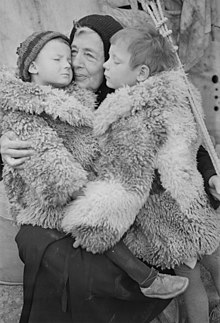 A Polish woman and her grandchildren at an American Red Cross evacuation camp in Tehran, Iran
|
Following the Soviet invasion of Poland at the onset of World War II, in accordance with the Nazi–Soviet Pact against Poland, the Soviet Union acquired more than half of the territory of the Second Polish Republic or about 201,000 square kilometres (78,000 sq mi) inhabited by more than 13,200,000 people.[1] Within months, in order to de-Polonize annexed lands, the Soviet NKVD rounded up and deported between 320,000 and 1 million Polish nationals to the eastern parts of the USSR, the Urals, and Siberia.[2] There were four waves of deportations of entire families with children, women, and elderly people aboard freight trains from 1940 until 1941. The second wave of deportations by the Soviet occupational forces across the Kresy macroregion, affected 300,000 to 330,000 Poles, sent primarily to Kazakhstan.[3]
Thanks to a remarkable reversal of fortune well over 110,000 Poles, including 36,000 women and children, managed to leave the Soviet Union with Anders' Army. They ended up in Iran, India, Palestine, New Zealand, and British Africa, as well as in Mexico.[4] Among those who remained in the Soviet Union, about 150,000 Poles perished before the end of the war.[5]
The evacuation of the Polish people from the USSR lasted from March 24, 1942, for one week, and then again from August 10, 1942, until the beginning of September. In the first stage, more than 30,000 military personnel and about 11,000 children left Krasnovodsk (Turkmen SSR, present-day Turkmenistan) by sea for Bandar Pahlavi. In the second stage of evacuation from the interior, more than 43,000 military personnel and about 25,000 civilians left with General Władysław Anders across the Caspian Sea to Iran. About one third of the civilians were children. A smaller-scale evacuation to Ashkhabad-Mashhad followed, including the large and final group of civilians.[4][6]
- ^ Piotr Eberhardt, Political Migrations on Polish Territories (1939–1950). Polish Academy of Sciences, Stanisław Leszczycki Institute of Geography and Spatial Organization. Monographies, 12. Page 25.
- ^ Piotr Wróbel (2000). "De-Polonizing the territories newly incorporated into the USSR". The Devil's Playground: Poland in World War II. The Canadian Foundation for Polish Studies of the Polish Institute of Arts & Sciences. Price-Patterson Ltd. ISBN 0969278411. Archived from the original on 2018-04-27. Retrieved 2016-07-02.
- ^ Hope, Michael (2005) [2000]. Polish Deportees in the Soviet Union. London: Veritas Foundation. ISBN 0-948202-76-9. – From Foreword by Dr. Tomasz Piesakowski 1998 reprint with excerpts by Waldemar Wajszczuk. See also: Derek Crowe, book review with excerpts.
- ^ a b Andrzej Szujecki (2004). "Near and Middle East: The evacuation of the Polish people from the USSR". In Tadeusz Piotrowski (ed.). The Polish Deportees of World War II: Recollections of Removal to the Soviet Union and Dispersal Throughout the World. McFarland. p. 97. ISBN 0786455365.
- ^ Tomasz Szarota & Wojciech Materski (2009), Polska 1939–1945. Straty osobowe i ofiary represji pod dwiema okupacjami (The human losses among Poles between two occupational forces), Warsaw: Institute of National Remembrance, ISBN 978-83-7629-067-6 (Excerpts reproduced online).
- ^ IWM (2016). "Evacuation of Polish civilians from the Soviet Union to Persia 1942". E 19030: IWM Collection. Imperial War Museums.